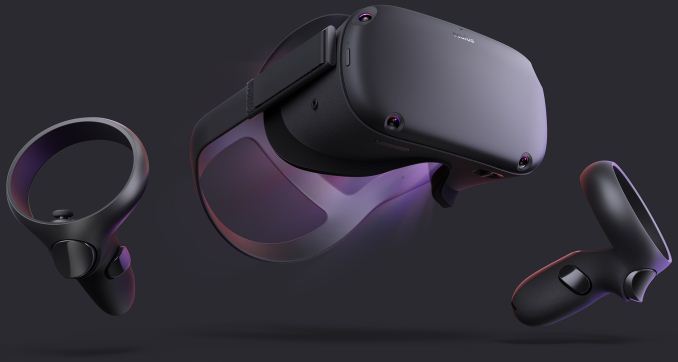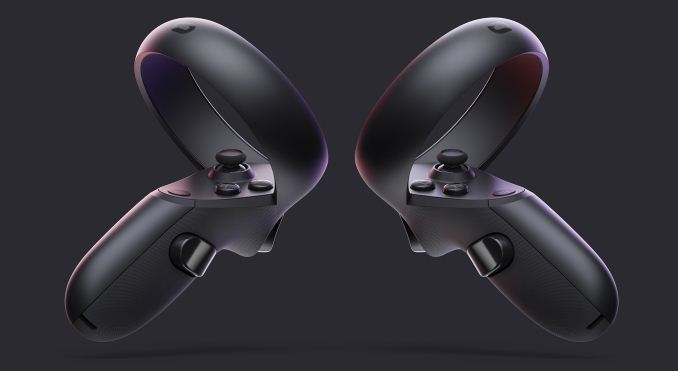Oculus Quest Announced: A 6DoF Standalone VR Headset
by Anton Shilov on September 27, 2018 5:00 PM EST- Posted in
- VR
- Oculus
- Oculus Quest

Oculus VR this week introduced its next all-in-one untethered VR headset, based around a 6-degree-of-freedom (6DoF) positional tracking system as well as the same optics as the Oculus Go launched earlier this year. Essentially an upscale, more powerful iteration of the Oculus Go, the new Oculus Quest will hit the market next spring at a price starting from $399.
The key feature of the Oculus Quest is its inside-out 6-degree-of-freedom (6DoF) positional and controller tracking that does not need any external sensors or a PC. The manufacturer says that tracking relies on four ultra-wide-angle sensors and computer vision algorithms, but does not go beyond that. When it comes to display subsystem of the Oculus Quest, the developer claims that the new unit has the same optics as the Oculus Go, but a display with a 3200×1440 (1600×1440 per eye) resolution (up from 2560×1440).
Besides graphics, Oculus VR also indicates improvements of built-in audio capabilities of the headset. Last but not least, the Oculus Quest will ship with its own Touch controllers that work just like controllers of the Oculus Rift, which will be a welcome upgrade when compared to the current-gen untethered Oculus Go headset that comes with a very simplistic controller.
Oculus VR has not disclosed which SoC it plans to use with the Quest, but considering the fact that the chip has to run games in a higher resolution than the Oculus Go and also process computer vision algorithms (unless Oculus VR uses a special purpose chip for them), it is safe to say that the new headset uses some kind of highi-end SoC (ed: it's since been confirmed that the SoC is a Snapdragon 835).
When it comes to games that take advantage of the Oculus Quest, the manufacturer promises that “over 50” titles will be available at launch, including games originally developed for Rift, such as Robo Recall, The Climb, and Moss.
The inclusion of Touch controllers as well as a more advanced SoC naturally had an effect on pricing of the new headset. The Oculus Quest 64 GB model will cost $399 (and this price alone implies on a more powerful SoC than the Qualcomm Snapdragon 821 used for the Go), which means that the unit will sit right above the Oculus Go ($199 - $249), but will still be more affordable than the Oculus Rift ($399) which requires a high-end gaming PC to function.
Related Reading:
- Oculus Go Now Available: Mainstream Standalone VR Headset Starts at $199
- HTC’s Standalone Vive Focus to Launch Worldwide This Year
- HTC Vive Pro HMD Pre-orders Start Today for $799; Vive Reduced to $499
- Lenovo Details Its Standalone Daydream VR HMD, The Mirage Solo at CES 2018
- HTC at CES 2018: Vive Pro VR Headset with Higher-Res Displays, Two Cams, Headphones
- VR Startup Varjo Announces Shipping of High Resolution Headset Prototype, Aimed at Professional Markets
Source: Oculus VR


















26 Comments
View All Comments
Cariboo - Thursday, September 27, 2018 - link
" it is safe to say that the new headset uses something that belongs to the ultra-high-end of the SoC space."What? Oculus has already disclosed that the Quest is powered by a shitty Qualcomm Snapdragon 835 (2 years old SoC).
mode_13h - Thursday, September 27, 2018 - link
Did any devices actually *ship* with the 835, in 2016? I think it's an exaggeration to say it's 2 years old, but definitely more than 1.And is the previous generation of their high-end SoC *really* so bad? What more can one realistically expect, in a $400 product that also needs a good screen, optics, and sensors for inside-out tracking?
SL4KR - Thursday, September 27, 2018 - link
Plus using slightly older hardware let's you have the time to optimize code, I would suspect.Jon Tseng - Friday, September 28, 2018 - link
Also bear in mind it should be less thermally constrained in the headset than in a smartphone, so you probably get better clocks and performance than stock.Although still some way behind a proper PC CPU/GPU combo, for sure.
qlum - Friday, September 28, 2018 - link
less thermaly constrained yes but you still don't want to use to big a battery or heatsinks and its use case resolves around a constant heavy load upon the soc so don't expect a bog improvementPeachNCream - Friday, September 28, 2018 - link
As others have pointed out, Facebook needed time to integrate the SoC into the design. This isn't phone hardware running on a standard Google operating system so there was probably a lot more work involved. Atop that, Facebook is an advertising company not a cellular phone manufacturer so they don't have the background in quickly bringing a new SoC to market. They have to nail an awful lot down to get the monetization of the platform into place so we ought to give them credit where its due that a new Oculus even got released with a Snapdragon 835 instead of some older SoC.29a - Thursday, September 27, 2018 - link
I am able to run a game on my computer and wirelessly stream it to a laptop connected to my tv and I think nvidia sheild tv can do the same thing. All of the work is done on my gaming computer, and sent to the laptop all it does is display the game on the tv and handle controller input. Why is there not a VR headset that does all the work on the computer and send it to the headset wirelessly, greatly reducing the computing power required in the headset, while greatly expanding the power of the headset?mode_13h - Thursday, September 27, 2018 - link
There's now an official wireless kit for the Vive Pro.I wonder if Rift v2 will be wireless out-of-the-box, although Nvidia probably added that USB-C port to their new FE card for a good reason...
Anyway, it needs to be a purpose-built wireless link, due to the bandwidth and latency requirements. You wouldn't want to use standard wifi.
That said, you might almost get away with it by putting some motion-compensation in the HMD, that would warp the image to match the change in HMD pose, between when the image was rendered and when the HMD received it. There'd probably be some artifacts, not least because you'd have to use something like H.264 compression, which would add further latency.
Diji1 - Friday, September 28, 2018 - link
>it needs to be a purpose-built wireless linkNo it doesn't, the HTC Vive wireless solution uses Wigig.
Diji1 - Friday, September 28, 2018 - link
And that, if we are to believe hands on reviews at the moment, works flawlessly.